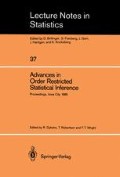Abstract
The isotone regression problem of finding a least squares isotone sequence is extended by imposing order restrictions also on higher order differences of the sequence. This new problem has a number of applications, and one example in the area of software reliability is presented.
In contrast to the isotone regression problem, there is no simple finite algorithm for solving least squares problems when higher order differences are also order restricted. The paper discusses some of the numerical difficulties which may arise due to the ill-posed nature of the problem and outlines a numerically stable algorithm for solving it.
Research supported by National Aeronautics and Space Administration Grant NAG-1-179.
AMS 1980 subject classifications: 6OK10, 62M99, 62N05, 65KO5, 68N99, 90C20, 90C50.
Access this chapter
Tax calculation will be finalised at checkout
Purchases are for personal use only
Preview
Unable to display preview. Download preview PDF.
References
Barlow, R.E., Bartholomew, D.J., Bremner, J.M. and Brunk, H.D. (1972). Statistical Inference Under Order Restrictions. Wiley, New York.
Crow, L.H. (1974). Reliability analyses for complex, reparable systems. Reliability and Biometry (F. Proschan and R.J. Serfling, eds.), SIAM, Philadelphia, 379–410.
Duane, J.T. (1964). Learning curve approach to reliability monitoring. IEEE Trans. Aerospace 2, 563–566.
Dykstra, R.L. (1983). An algorithm for restricted least squares regression. J. Amer. Statist. Assoc. 78, no. 384, 837–842.
Feller, W. (1968). An Introduction to Probability Theory and Its Applications. Vol. I, 3rd ed. Wiley, New York.
Feller, W. (1971). An Introduction to Probability Theory and Its Applications. Vol. II, 2nd ed. Wiley, New York.
Gill, P.E. and Murray, W. (1977). Modifications of matrix factorization after a rank-one change, in State of the Art in Numerical Analysis (D. Jacobs, ed.). Academic Press.
Gill, P.E. and Murray, W. (1978). Numerically stable methods for quadratic programming. Math. Programming, 14, 349–372.
Goel, A.K. and Okumoto, K. (1979). Time-dependent error detection rate model for software reliability and other performance measures. IEEE Trans. Rel. R-28, 206–211.
Golub, G.H. and Van Loan, C.F. (1983). Matrix Computations. The Johns Hopkins University Press, Baltimore, Maryland.
Jelinsky, Z. and Moranda, P. (1972). Software reliability research. Statistical Computer Performance Evaluation (W. Ferberger, ed.). Academic Press, New York, 465–484.
Littlewood, B. (1981). Software reliability growth: A model for fault-removal in computer-programs and hardware-design. IEEE Trans. Rel. R-30, 313–320.
McCormick, G.P. (1983). Nonlinear Programming: Theory, Algorithms and Applications. Wiley, New York.
McWilliams, T.P. (1979). Properties of isotonic estimators of mean lifetime in a simple prototype development model, TR-194. Department of Operations Research and Department of Statistics, Stanford University, Stanford, California.
Miller, D.R. (1986). Exponential order statistics models for software reliability growth. IEEE Trans. Software Eng. SE-12, 12–24.
Miller, D.R. and Sofer, A. (1985). Completely monotone regression estimates of software failure rates. Proceedings of Eighth International Conference on Software Engineering. IEEE Computer Society Press, Washington, D.C., 343–348.
Musa, J.D. and Okumuto, K. (1984). A logarithmic Poisson execution time model for software reliability measurement. Proceedings of Seventh International Conf erence on Sof tware Engineering. IEEE, New York, 230–238.
Nagel, P.M., Scholtz, F.W. and Skrivan, J.A. (1984). Software reliability: Additional investigations into modeling with replicated experiments. CR-172378, NASA.
Author information
Authors and Affiliations
Editor information
Editors and Affiliations
Rights and permissions
Copyright information
© 1986 Springer-Verlag Berlin Heidelberg
About this paper
Cite this paper
Miller, D.R., Sofer, A. (1986). Least-Squares Regression Under Convexity and Higher-Order Difference Constraints with Application to Software Reliabiilty. In: Dykstra, R., Robertson, T., Wright, F.T. (eds) Advances in Order Restricted Statistical Inference. Lecture Notes in Statistics, vol 37. Springer, New York, NY. https://doi.org/10.1007/978-1-4613-9940-7_6
Download citation
DOI: https://doi.org/10.1007/978-1-4613-9940-7_6
Publisher Name: Springer, New York, NY
Print ISBN: 978-0-387-96419-5
Online ISBN: 978-1-4613-9940-7
eBook Packages: Springer Book Archive

